Environmental factors of transaction costs
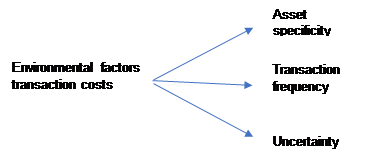
Note. Own elaboration
Outsourcing as a production model and customer loyalty of a financial company
(*)Morelia Magaly Barra Solano; (**)Luis Florencio Mucha Hospinal; (***)Edith Pilar Quispe Espinoza; (****)Sonia Luz Barzola Inga; (*****)Vilma Hermelinda Munive Orrego
(*)Universidad Peruana Los Andes
Facultad de Cs. Administrativas y Contables
Huancayo, Perú
MagalyBSAcount@gmail.com
(**)Universidad Peruana Los Andes
Facultad de Cs. Administrativa y contables
Huancayo, Perú.
luismuchahospinal@gmail.com
(***)Universidad Peruana Los Andes
Facultad de Cs. Administrativas y Contables
Huancayo, Perú
ep.quispespinoza@gmail.com
(****)Universidad Peruana Los Andes
Facultad de Cs. Administrativa y Contables
Huancayo, Perú.
Sbi_pe@hotmail.com
(*****)Universidad Peruana Los Andes
Facultad de Ciencias Administrativas y Contables Académica
Huancayo, Perú.
Vilma266@gmail.com
Reception date: 03/01/2023 – Approval date: 04/20/2023
DOI: https://doi.org/10.36995/j.visiondefuturo.2023.27.02.004.en
ABSTRACT
Companies in the globalized world use outsourcing as a production model, opting for subcontracting from companies specialized in different areas of work. In this context, the objective of this study is to determine the relationship between outsourcing as a productive model and customer loyalty of a financial company, for which the type of applied research and descriptive-correlational design were used. The survey questionnaire was applied to collect data on the variables and dimensions. Results, it was found that the relationship between outsourcing and Customer loyalty in a financial company is considerable, with a correlation coefficient τ = 0.628 and p = 0.000, the analysis between the flexibility and information dimensions was moderate τ = 0.412 and p = 0.000, between cost savings and moderate internal marketing τ = 0.487 and p = 0.000, and between professionalism and considerable communication τ = 0.535 and p = 0.000, between quality of service and considerable customer experience τ = 0.696 and p=0.000. With these results it is concluded that outsourcing as a productive model of the company is moderately related to customer loyalty. Therefore, the financial institution must externalize the specific responsibility to specialized external companies.
KEYWORDS: Outsourcing; Customer loyalty; Internal marketing; Quality of service.
INTRODUCTION
Outsourcing as a productive model and customer loyalty in a financial institution are essential in the administration and management of resources in the business sector, since every manager's decision is manifested in the profit acquired by the company, outsourcing focuses on hire another specialized company to carry out a specific activity, Jay et al., (2022) affirm that, Innovation is one of the benefits that is expected today in outsourcing commitments, on the other hand, the International Labor Organization (OIT, 2020), cited by Soriano and Alarcón, (2022). They add that outsourcing is when an organization transfers ownership of a business process to an external source. The key to this definition is the aspect of transfer of control. In this case, the assumptions made by the authors are replicated in financial companies and in other institutions, not only financial but also in private and public institutions.
The financial company, by going to an external company with profiles of owning the sale of products, and not seeing successful results with the logistics team, transfers said activity to a company specialized in marketing, thereby seeking an increase in customers and subsequent loyalty to Through the products with a new offer innovation, the subcontracted company then has a clear objective of retaining customers. The management of the value chain is to guarantee competitive advantages and build customer loyalty with the brand (Shah and Murthi, 2021). Based on the considerations Checasaca et al., (2022), add that companies need to retain customers, using a wide range of elements and technologies to build a solid, satisfactory and lasting relationship with customers. It means then that companies need to know their customers in depth, analyze their characteristics in order to segment them and design loyalty strategies aimed at those who are most attractive for business growth. (Santamaria and Oliva, 2011)
Research on customer loyalty has provided a lot of attention from companies and other organizations, the reason is that companies seek to win the preference of customers, loyalty helps to retain, improve strategies in order to get more customers. A company with these characteristics can increase its sales and position itself in the market, loyalty implies establishing solid links and maintaining long-term relationships with customers (Cabrera, 2014), also loyalty is the process of acquiring new customers, retaining and create relationships with them in order to promote and sell the organization's products and services. (Fernández et al., 2022)
The assumptions raised in previous paragraphs, merits formulating the research problem:
What relationship exists between outsourcing as a productive model and customer loyalty of a financial company?
The main objective of the exposed problem was to determine the relationship between outsourcing as a productive model and customer loyalty of a financial company, the work is justified, because it aims to solve and verify the problems that arise in companies that outsource a specific activity, In this sense, a thorough investigation and detailed explanation of the relationship between outsourcing and customer loyalty was carried out.
Finally, the research provides the management of Outsourcing as a productive model of work independent of the financial, it focuses on seeking customer loyalty. Under this approach, it is intended to contribute knowledge to Marketing studies, and the decision to convene specialized independent companies, with whose contribution to increase the development of a financial institution.
DEVELOPMENT
Research Background
Research on Outsourcing has increased persistently in recent years, due to the change in customer behavior, the subject has been included in the university curricula of the faculties of Administration, the Outsourcing approach is an área of knowledge that is has published as an empowerment strategy granted by companies or institutions to third parties. Dean et al., (2013) affirm that outsourcing is when a certain activity is no longer carried out by the workers of a company and is transferred to another company.
This topic has been discussed in many Latin American universities. In Colombia Picón., et al., (2022) show that the benefits of SMEs through ICT in the international trade of outsourcing services, adapt to new trade patterns, to compete in the international market, services outsourcing companies provide more sophisticated, new and modern services in México. Armendáriz et al., (2022) affirm that, the administration of our times recognizes, as a plan for better efficiency and productivity in the company, the external contracting of labor and services.
As can be seen, the experiences in both Colombia and México, is that outsourcing services fulfill an effective collaboration function in the different activities, these outsourced companies are not dedicated to the main work of the company but rather contribute with a specialized team in the functions that the company assigns them, the objective is to increase production, access new technologies and/or reduce costs within the company.
Ortiz et al., (2019) state that companies in the pharmaceutical and cosmetic sector increasingly demand storage outsourcing services with the aim of improving their operational efficiency, reducing costs, complying with current regulations and focusing on their court business, likewise Jones et al., (2021) point out that outsourcing does not separate companies from investing in the development of internal technological skills, having trained and trained personnel and promoting links with the environment to gain competitiveness through of the improvement of internal processes, the use and optimal management of information.
Conceptual framework
Regarding the variable outsourcing and dimensions
Outsourcing
The review of the literature indicates that Outsourcing is a productive model for the externalization of external activities and/or specialties of outside or external companies, which contribute to the good development of any financial, educational, and hospital institution, are observed in these institutions, security personnel, infrastructure maintenance, cleaning services, etc. Throughout the 20th century, companies began to grow, and with it the increase in activities, precisely this need is What is transferred to another company.
Handfield, (2006). He mentions that, to solve this situation, some companies began to analyze which of the processes they carried out were critical or key to the development of their activities and thus focus on them, and identify which ones could be outsourced to reduce the workload. internally and, at the same time, have expert advice.
Sosa, (2022) states that outsourcing is positive, in that it contributes to the optimization of the company's production processes and responds to the requirements of an increasingly globalized and competitive economy. In the same way, Moench (2022) mentions that outsourced companies provide "business services" whose main activity is to be the direct relationship link with the clients of a varied cluster of companies that hire them. The aforementioned authors define Outsourcing as an activity that outsourced companies undertake and carry out activities external to those carried out by the company, on the other hand. Ramírez et al., (2021) specify that Outsourcing allows companies to focus on the strategic aspects of the business and leave the details of the operation to external experts.
Transaction cost
Richardson (1972) cited by Gorbaneff, and Cabarcas, (2009). They show that the activities undertaken by companies could be coordinated in three basic ways: through market transactions, through cooperation and through management. In addition. Peirano, (2014). He mentions that the management of the environment leads to the need to identify and specify the borders of the company. The theoretical conception of the company has evolved and it is accepted that the frontiers of the activity need, in turn, a new revision to incorporate the human, environmental and social dimensions, and allow a management of non-economic environments.
In turn (Williamson, 1981) cited by García, and Taboada, (2012), They indicate that the transaction. It is a concept that includes both the notion of exchange and that of a contract. The exchange of property rights for goods and services does not imply a promise of future liability and is typically exemplified by market transactions. The contract does carry a promise of future performance, essentially because one party has made an investment and its return depends on the behavior of the other party in the future. The exposed assumptions invoke that the productive model of outsourcing, chooses to make an agreement with outsourced companies, for the execution of certain specialized activities, under the legalization of the contract.
According to Williamson, some aspects to carry out the transaction in the market, is the cost of the search, also known as location, the location of third-party companies causes costs to the company in the search, the objective is that the located companies must exercise or provide services, with a high level of competitiveness, therefore, this type of cost places trust in the quality of services provided by the contracted company. Fernández, (2018) declares, for the commitments acquired by the parties, they can foresee the mechanisms, to establish and fix common rules that generate trust throughout the exchange relationship.
Another aspect is the cost of the negotiation, the contract with an outsourced company generates costs, therefore, it is necessary to reach a positive agreement by both parties. Huacre (2017) specifies that negotiation is a decisive action to close contracts, have strategic alliances and grow in both the national and international markets, the person in charge of the negotiations evaluates the pieces that must be moved in order to emerge victorious.
However, both advertising costs and negotiation costs should not be affected by the performance of the transactions, but what happens if one of the parties does not fulfill the contract. Lage, Cruz. (2022). They specify that the cost of enforcement raises the importance of the rules of the game being correctly designed, which means that the regulations are well drafted and generate the right incentives, insists on the importance of complying with these rules. For this, it is necessary that the regulations are respected and that the authorities have the capacity to enforce them.
Transaction cost factors
Companies that carry out activity transfer contracts take into account some factors that intervene at the time of execution. According to Oliver Williamson (1973) cited by Fernández, (2018a) there are certain environmental factors that contribute to understanding the participation of the subjects involved in the contract:
Figure No. 1
Environmental factors of transaction costs

Note. Own elaboration
Dimensions of the Outsourcing variable
Outsourcing, as a productive business model, is important in the contribution that the external company makes, this type of management influences the decision making of senior management, to incorporate as a competitive contribution in the development of an organization. The dimensions assumed by outsourcing are:
Figure No. 2.
Outsourcing Dimensions
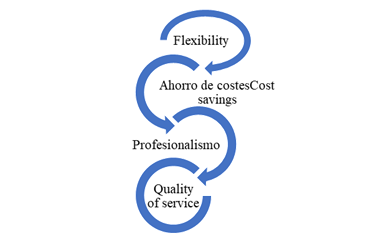
Note. Own elaboration
Flexibility
Flexibility is a very important dimension, since the company outsources the processes of growth or reduction of productive capacity in a very simple way. Flexibility refers to the ability to respond to changes and the degree of adaptability to deal with changing circumstances. Espino, (2003), adds, when an organization adopts outsourcing, they become more flexible, more dynamic and are able to better face the changes and opportunities that are presented to them.
Cost savings
Cost savings is another very vital dimension, whose value lies in reducing logistics costs, those that harm profitability, and thus reduce the competitiveness of the company. Sánchez et al., (2019). They state that the quantification of the costs and the identification of the factors determine information to be able to carry out a cost-benefit analysis. Hurtado, (2021) complements, to reduce production costs, outsourcing the production cost is lower, therefore, it generates greater profitability
Professionalism
The external company must have professionalism, capable of maximizing the management of the company, subcontracted companies must be motivated and focused on achieving the assigned objectives. Argyriades and Demetrios, (2012) state that professionalism in government, or in any other field, is based on competence, is a special body of knowledge or a defined ability, acquired through study and practice, on the other hand. Alejandro and Reinoso, (2022) complement that professionalism is a multidimensional competence based on attitudinal and cognitive skills that allows professionals in any field to perform better in their workplaces.
Quality of service
The companies that carry out the support work for the management of the organization have years of experience in the service they provide. This management allows organizations to optimize their customer service effectiveness and reduce risks and setbacks in their management processes. Silva et al., (2021). They assume that service quality is understood as the gap that exists between customer expectations and their perceptions after receiving a service. Fontalvo and De la hoz, (2020). They add that the quality of service is one of the main determinants of customer satisfaction, it is a multidimensional construction, whose dimensions differ from one sector to another.
Customer loyalty
Loyalty is a fundamental aspect of the company, it is to guarantee the return of customers to purchase the products and their innovations whenever required, but the company achieves this habit thanks to the good treatment, quality and offers of its products.. Pierrend (2020) mentions that loyalty is understood as an action aimed at ensuring that customers maintain stable and continuous relationships with the company over time. On the other hand, Paredes et al., (2022). They expand that customer loyalty is above all to satisfy the needs of customers through tools that allow interaction with them while maintaining a more direct relationship.
Dimensions of the customer loyalty variable
The dimensions of the variable, customer loyalty, are operationalized based on the conceptual definition, which is the basis for building these subvariables.
Figure No. 3.
Customer loyalty dimensions
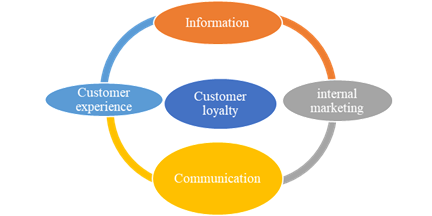
Note. Own elaboration
Information
The client approaches the company according to his interests, these can be according to the types of products it sells, the company reaches the public through information, this information is received through different channels, written, oral and virtual. Alcaide, (2015) mentions that the information acts in only one direction; someone sends a message and another person receives it and endorses the content of that message. Oliveros et al., (2022). He adds that information can be understood as a structure, which consists of a combination of various cognitive communication systems, a symbolic figure of knowledge in transmission, and a process of identifying irregularities in the knowledge of the receiver.
Under these approaches, it follows that information has a very important role for companies to relate to the customer, promoting effective information management, with key aspects of the product with which they seek to attract the consumer.
internal marketing
Internal marketing is, as an organizational apprenticeship, managers develop, with collaborators and suppliers, the teaching-learning of the vision and mission and work strategies of the company, so that the collaborator, by empathizing with the philosophy of the company, becomes feel identified with it, this internal organization with this knowledge promoted turns the company into high levels of competitiveness. According to Severino et al., (2022). Companies that, from the perspective of marketing or marketing, implement strategies related to social causes, have shown a significant impact on consumer purchasing decisions.
Communication
Communication as a dimension of customer loyalty, is a priority action in the management of any company, this management is key for the work teams to integrate and complement each other in all the activities of the company, with the aim of achieving objectives jointly. Rooms, (2022). It specifies that communication is considered a fundamental axis, since through it is possible to elaborate agreements that enable the integration of collaborators, as well as obtaining the objectives set through organized teamwork.
Customer experience
The customer experience is based on the way the company must relate to customers, this relationship can be through social, written, oral, and personal networks through physical attention at the company's facilities, in short, it is all the interrelationships that a customer has with the product brand. Cachero, and Vázquez, (2017) mention that the customer experience is modified by the changes in perception that customers have and the format of department stores that influence this dynamism. On the other hand, Pekovic, and Rolland, (2020) affirm that companies, in order to guarantee the repurchase of their customers, not only need to pay attention to their needs, but also to the experiences they live.
Methodology
The type of research was applied, with a descriptive correlational design, applied because the study of the problematic reality, is nourished by theories raised to the study variables, as well as the dimensions (Mucha et al., 2022), the descriptive correlational design, with the objective of evaluating the relationship that exists between two or more variables.
Participants
45 collaborators participated, of the total, 55% were women and 45% men, in the study three outsourced companies were summoned, the purpose was, through Outsourcing, to seek the loyalty of the clients of the financial CrediScotia. The collaborators who participated were professionals specialized in marketing, and familiar with the outsourcing model. The sample cannot be separated from the population, because, in essence, it will produce the information with certain veracity. (Mucha and Lora, 2021)
Instrument
The instrument was built, with the operationalization matrix technique, from the variables and the conceptual, operational definition, dimensions and indicators to specify the items followed by the response, this construction was based on the theoretical framework and background, There were two instruments: a questionnaire called outsourcing in the financial company CrediScotia made up of 4 dimensions each with 5 items in total for the 20-item variable and a questionnaire for customer loyalty made up of 20 items. Each item had the responses of never, almost never, sometimes, almost always and always, the scale used was the ordinal scale from 1 to 5.
The judges validated the instrument, based on the criteria: sufficiency, clarity, coherence and relevance. A total of 7 experts in the field were consulted, who provided the validity of the high-level instrument. The content validity methodology that contemplates the evaluation of expert judges in the subject (Navarro et al., 2022) was used, after the validity, the reliability of the instrument was carried out, applying to a pilot sample, composed of 20 subjects, with the same characteristics of the study sample. The results of the survey were processed using Cronbach's Alpha coefficient, yielding a result of 0.98, achieving high reliability. Cronbach's Alpha coefficient ranges between 0 and 1, considering an acceptable coefficient when its value is equal to or greater than 0.7, noting that the higher the Alpha value, the greater the internal consistency and confidence. (González et al., 2022)
Data analysis method
The data was tabulated and organized in frequency tables for the descriptive study, the analysis of the tables was through the percentage frequencies, and the interpretation of the variables and dimensions were qualitative, and to confirm the objectives and hypothesis it was used the contrast of hypothesis, using Kendall's Tau-b correlation coefficient for ordinal data, and the statistical test using the Z test. The analysis of the data implies a transcription of the data and for this reason it is recommended that personally the transcription (Rodríguez, and Medina 2014). The data was processed using the SPSS 25 statistical software. Prior to the statistical treatment, the data was organized by intervals on the scales from 1 to 5 according to response categories (Table 1 and Table 2).
Construction of intervals by categories for the Outsourcing variable
Table No. 1
Outsourcing intervals by categories
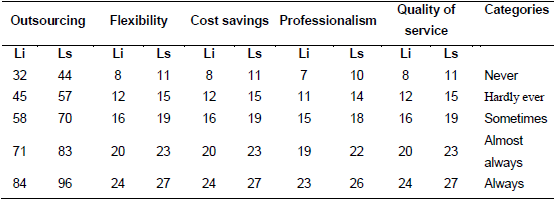
Note. Own elaboration
Construction of intervals by categories for the customer loyalty variable
Table No. 2
Customer loyalty intervals by categories

Note. Own elaboration
Results
After the field work, the data was organized in frequency tables, the descriptive study was analyzed with a qualitative interpretation and inferential statistics were used for the validity of objectives and hypothesis. Moreno et al., (2018) state that, once the selection of the data is finished, all the information relevant to the question must be obtained from them, the analysis of the results reveals the following:
Descriptive study
Table No. 3
Association between variables Outsourcing and customer loyalty
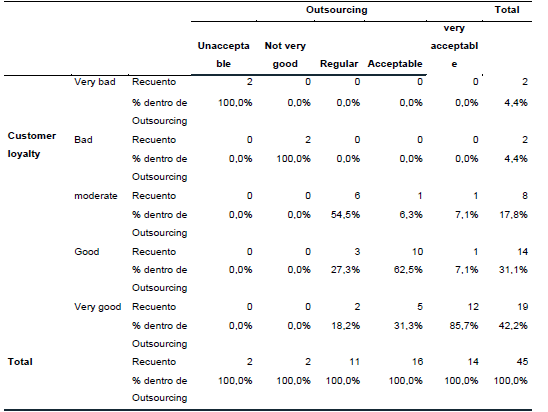
Note. Prepared by the author
Table 3 shows that 4.4% of respondents say that loyalty is very bad.
This percentage is higher in people who say that outsourcing is unacceptable. 17% state that loyalty is moderate and the management of the outsourced company is regular at 54.5%, only 7.1% say it is acceptable. There is a percentage relevance of 42.2% and 31.1% of very good and good opinion, the company hired to build loyalty is acceptable at 62.5%. The descriptive study of the association of the variables Outsourcing and customer loyalty shows an acceptable association in the opinion of the surveyed gentlemen, stating that Outsourcing as an external management manages to build customer loyalty with the promotion and sale of products.
Table No. 4
Comparison by categories by dimensions of the Outsourcing variable

Note. Own elaboration
Table 4 shows the comparative percentage results in the dimensions, of the Outsourcing variable, in which it is observed that the regular and acceptable opinion reach 75.5% in the flexibility dimensions, in cost savings they reach 62 .3% in the professionalism dimension 57.7% and in quality of service 64.5%, there is a non-relevant percentage difference between them, the flexibility dimension slightly reaches a higher percentage, according to Sánchez et al., (2023) the agreements with third parties allow to increase market coverage, improve the level of service or increase flexibility towards change, they are more formal and binding than associations, services are much more tailored to the requirements of a specific client.
Table No. 5
Comparison of opinions by dimensions of the customer loyalty variable

Note. Own elaboration
Table 5 shows the comparative percentage results in the dimensions of the customer loyalty variable, in the customer information dimension, moderate, good and very good opinions reach 91.2%. In the cost savings dimension 75.6%.
In the professionalism dimension 86.6% and in quality of service 96.7%. In all dimensions the opinions are favorable, deducing that the outsourced company performs a good management in customer loyalty, customer loyalty is achieved with a good quality of service, therefore the percentage difference with the other dimensions is significant. According to Rojas et al., (2020). The quality of service is determined by the different perceptions of the client according to their need, it is there where the best attributes must coincide when the client demands a product or service, to satisfy said need at the precise moment.
Hypothesis contrast
Determine the relationship between Outsourcing and customer loyalty of a financial company.
To analyze the relationship, the Kendall Tau-b correlation coefficient was applied.
Correlation coefficient between Outsourcing and customer loyalty

a. The null hypothesis is not assumed.
b. Use of the asymptotic standard error that presupposes the null hypothesis.
The relationship between Outsourcing and customer loyalty of a financial company is determined, with a correlation coefficient T=0.659 with a p-value of 0.000, which shows that the relationship between both variables is considerable.
These results are similar to the work of Tello (2018), in his research he addressed the relationship between Outsourcing and customer satisfaction in the Mortgage Business área, he concludes that the relationship between both variables is low. Likewise, it coincides with the work of Echevarría (2019) called digital Outsourcing and its incidence in the level of information in Metropolitan Lima for the decision-making of a group of companies. Lime. 2019, concludes that the use of the digital tool in an outsourcing service significantly improves the level of information for decision making.
Hypothesis testing
Formulation of the hypothesis: There is a significant relationship between Outsourcing and customer loyalty of a financial company.
To prove the hypothesis, the chi-square test was applied.

a. 23 cells (92.0%) have expected a count less than 5. The minimum expected count is .09.
It is appreciated x^2= 116,034 at gl=16 and with a p-value of 0.000 demonstrating the scientific hypothesis that the relationship is significant between Outsourcing and customer loyalty of a financial company. According to Acoltzin (2014). The goal of statistical significance tests is to calculate the p-value, which is the probability that the null hypothesis is true.
CONCLUSIONS
After analyzing and discussing the outcome of the investigation, according to the objectives and problems raised, they consent to reach the successive conclusions:
It was established that outsourcing and customer loyalty have a considerable relationship, due to the actions carried out by the sales force that is in charge of outsourcing, the same ones that are absolutely involved in the service process, from the client's entry to the establishment to the exit
It was specified that there is a considerable relationship between flexibility and information, because the adaptation capacity is managed according to the established policies, providing the information to both collaborators and clients of the financial institution.
It was found that the cost savings and internal marketing have a considerable relationship, because the sales force was outsourced with the purpose of reducing the costs of recruitment and selection of personnel, in order to have qualified, experienced and voluntarily committed personnel, reducing Internal errors in the performance of their functions.
It was inferred that professionalism and communication have a considerable link, because the outsourced sales force intervenes directly in communication with the client, in this sense it reflects their professionalism.
It was established that the link is considerable in quality of service and customer experience, due to the particularity of the outsourced sales service that acts directly on the customer experience or the conceptualization of the service received.
Finally, it is appropriate to mention that the study in its development presented limitations, among them, time required in the surveys, subjects unwilling to collaborate, sample size. Therefore, it is recommended that the instrument be applied to a larger sample than the one used, in such a way that it can be generalized, through a statistical estimation study. Likewise, the instrument can be replicated in other studies, in other investigations related to outsourcing and customer loyalty. These investigations, as well as other lines may arise from the present study.
REFERENCES
Please refer to articles in Spanish Bibliography.
BIBLIOGRAPHICAL ABSTRACT
Please refer to articles Spanish Biographical abstract.